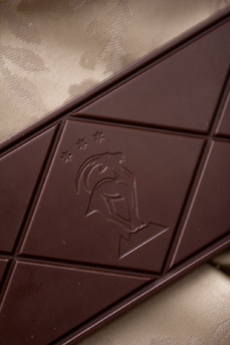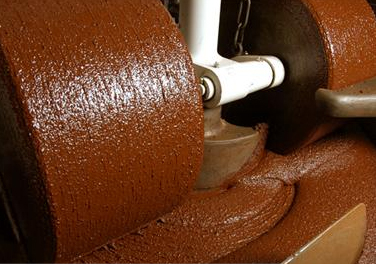

The Scharffen Berger logo features an ibex mountain goat and three stars. All photography by Saidi Granados.
|
PETER ROT is the THE NIBBLE’s chocolate specialist.
|
September 2008
|
 |
Scharffen Berger Chocolate
Page 4: Company History
This is Page 4 of a six-page article. Click on the black links below to visit other pages.
Scharffen Berger Chocolate Maker
By opening its doors in 1996, Scharffen Berger proclaimed that Americans who wanted a top quality, artisan chocolate bar no longer had to rely on Europe. Until then, most quality chocolate was produced in France, Belgium, Germany, Switzerland and Italy—far from its Mesoamerican birthplace. But in 1996, America’s second fine bean-to-bar producer debuted in the San Francisco Bay area, not far from E. Guittard, the first premium producer of chocolate (founded 1868).
Founded by two Californians, winemaker John Scharffenberger and physician Robert Steinberg, Scharffen Berger has played an important role in the history of chocolate, shaping the current trend of “micro” production* within the U.S. and, as a result, decentralizing production in Europe.
*A micro producer processes under 200 tons of beans a year. Amedei, for example, processes about 130 tons. Today, Scharffen Berger is no longer a micro producer.
The company was founded on a philosophy and practice deeply rooted in John Scharffenberger’s previous trade. As a producer of sparkling wines, John believed blending to be crucial to achieving a desirable and balanced flavor profile. Just as many sparkling wines, including most Champagnes, are a blend of several grape varieties (in the case of Champagne, Chardonnay, Pinot Noir and Pinot Meunier), so is Scharffen Berger’s chocolate a blend of several different types of cacao.†
†There are three different species of cacao: Criollo, Forastero and Trinitario. They can be grown in any region where cacao grows successfully, although some regions specialize in a particular species. Read more about each bean type in the Chocolate Glossary.
Robert Steinberg, too, had some ideas of his own. After spending time with the great French chocolatier Bernachon and proposing a business plan to John Scharffenberger for a new chocolate company, the two formed a legal partnership. Then, using a coffee grinder, mortar and pestle, an electric mixer and a hair dryer, the duo produced their first batches of chocolate in Robert’s kitchen, after testing nearly 30 samples of cacao.
 Soon after, the two purchased vintage European equipment and commenced production in a South San Francisco factory. Their chocolate was well received by local foodies, but the upstart company still required a few more tests to iron out a consistent flavor. Then, in just four short years, Scharffen Berger Chocolate Maker, as the company was called, outgrew the factory and relocated to a 27,000 square foot location in nearby Berkeley. Soon after, the two purchased vintage European equipment and commenced production in a South San Francisco factory. Their chocolate was well received by local foodies, but the upstart company still required a few more tests to iron out a consistent flavor. Then, in just four short years, Scharffen Berger Chocolate Maker, as the company was called, outgrew the factory and relocated to a 27,000 square foot location in nearby Berkeley.
Photo above: The conching machine. Before the chocolate is tempered, it must be kneaded and churned in the conch, removing moisture and acidity from the chocolate, Conching eliminates undesirable odors, fully evolves the desirable flavors and aromas, and further smoothes the particles.
Acquired by The Hershey Company in August 2005, Scharffen Berger is still committed to its founding principles, creating high-quality blended chocolate, largely dark bars, plus cocoa powder, nibs and panned products (such as chocolate-covered coffee beans and crystallized ginger).
Continue To Page 5: Scharffen Berger Style
Go To Article Index Above
Lifestyle Direct, Inc. All rights reserved. Images are the copyright of their respective owners.

|



 Soon after, the two purchased vintage European equipment and commenced production in a South San Francisco factory. Their chocolate was well received by local foodies, but the upstart company still required a few more tests to iron out a consistent flavor. Then, in just four short years, Scharffen Berger Chocolate Maker, as the company was called, outgrew the factory and relocated to a 27,000 square foot location in nearby Berkeley.
Soon after, the two purchased vintage European equipment and commenced production in a South San Francisco factory. Their chocolate was well received by local foodies, but the upstart company still required a few more tests to iron out a consistent flavor. Then, in just four short years, Scharffen Berger Chocolate Maker, as the company was called, outgrew the factory and relocated to a 27,000 square foot location in nearby Berkeley.